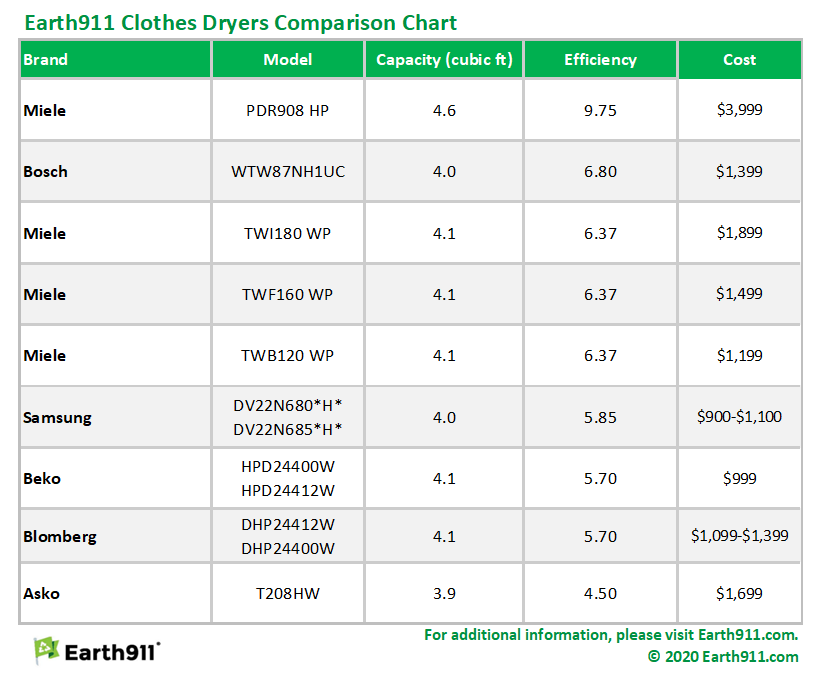People rarely shop for a clothes dryer by itself. It’s more common to buy washers and dryers as a pair. And usually, it’s the washer that gets more attention, even though dryers use more energy than any other home appliance. You could just get the dryer that matches the most efficient washer. You can even do without the dryer entirely. But if you want to minimize your energy use without spending your days in front of a clothesline, the most efficient dryers are not the ones that match the most efficient washers.
Comparison Criteria
Depending on how your home is powered, you may not have a choice about whether to buy a gas or electric clothes dryer. Energy Star certifies both types of dryers, but the Energy Star Most Efficient list for 2020 is made up entirely of ventless electric dryers that use heat pump technology. (There are also ventless condenser dryers, but these are not as efficient as heat pump dryers.) Ventless dryers are standard in Europe, but relatively new to America. Not only do ventless dryers run more efficiently but they allow you to seal off existing dryer vents. This prevents air leakage, reducing your energy usage for home heating and cooling.
For clothes dryers, efficiency is measured by Combined Energy Factor (CEF). The higher the CEF, the more efficient the clothes dryer. Energy Star certified dryers have CEF values that range from 2.68 up to 9.75, with energy savings from 20% to 60% compared to conventional clothes dryers.

A dryer that runs efficiently but doesn’t last very long or needs frequent repairs won’t save energy in the long run. Unfortunately, there isn’t much third-party data in the U.S. comparing the reliability of highly efficient clothes dryers. In Britain, where heat pump dryers are more common, the Telegraph’s top-rated heat pump clothes dryers were manufactured by Miele, Bosch, and Samsung.
Comparison Chart
Click the image below for a larger version of the clothes dryer comparison chart.
Rankings/Manufacturers
Miele PDR 908
One dryer far outperforms the rest with a CEF of 9.75. Although longer run times and smaller capacity are frequent complaints about ventless heat pump dryers, Miele’s 4.6 cubic-ft capacity PDR 908 heat pump dryer can handle 18 pounds of wet clothes, and claims to offer shorter drying times. At roughly $4,000, the German brand’s PDR 908 is by far the most expensive dryer on Energy Star’s Most Efficient list, but this appears to be a case of getting what you pay for. The British version of this model was the Telegraph’s top-rated dryer.
Bosch
At $1,400 and a CEF of 6.8, the second-ranked Bosch 500 series heat pump dryer is a big step down in both price and efficiency. It’s also a smaller machine, with 4.0 cubic feet capacity. It still comes with 14 dry cycles, including a sanitize cycle and ones for delicate fabrics, and promises a self-cleaning condenser. This German company ranked third on the Telegraph’s list of best dryers with what appears to be the same model wired for the UK.
Many Mieles
Not only does Miele take the top spot on the Most Efficient list, they fill out most of the middle. With 4.1 cubic feet of capacity and a CEF of 6.37, these three dryers seem identical at first. But the TWB120WP is a basic heat pump model with a price tag $800 less than the TWI180 WP EcoSteam WifiConn@ct smart appliance with a steam finish option for wrinkle-free clothes. Priced right in the middle of these two, the TWF160 WP Eco&WiFiConn@ct seems to be a Goldilocks solution with the same options as the pricier model.
Samsung
Samsung’s 4.0 cubic foot heat pump dryers all come in around $1,000 and have a CEF of 5.85. They offer as many settings as the more efficient dryers on the list. Of the brands with products on Energy Star’s Most Efficient list, only Samsung has been reviewed by Consumer Reports, which only evaluates the old-fashioned vented types of dryers that are still more common in America. Samsung’s vented dryers mostly score in the 70s, with their highest ranked model earning an 82 (Consumer Reports’ top score was 91). A larger Samsung model ranked fourth on the Telegraph’s list of best dryers.
Beko and Blomberg
Beko is a fairly new brand to American consumers, but it’s been around since 1967 and is available in 130 countries. Their most efficient clothes dryer has a capacity of 4.1 cubic feet and a CEF of 5.7. Blomberg, which is owned by the same Turkish parent company, sells a nearly identical heat pump dryer with the same CEF score.
Asko
The smallest dryer on the Most Efficient list, Asko’s Classic Heat Pump Dryer also has the lowest efficiency with a CEF of 4.5. However, if you have a small household and can afford a $1,700 dryer, it could be the right choice for you.
Best Practices
Even if you’re not matching washer and dryer, try to get the same size. Choose the right size for your household and only run properly filled loads. If your dryer is crammed too full it will have to run longer to dry the load, wasting energy. On the other hand, a dryer that is nearly empty uses the same energy as a full one per load.
Whatever model of dryer you buy, follow best practices to use it most efficiently. Consider using wool dryer balls instead of dryer sheets; use the sensor settings instead of timed dry; and if clothes are still dripping when you take them out of the washer, run them through an extra spin cycle before moving them to the dryer.
There is often an up-front cost premium for highly efficient appliances. Don’t forget to check for local rebates.
The post Buyers Guide: Clothes Dryers appeared first on Earth 911.








